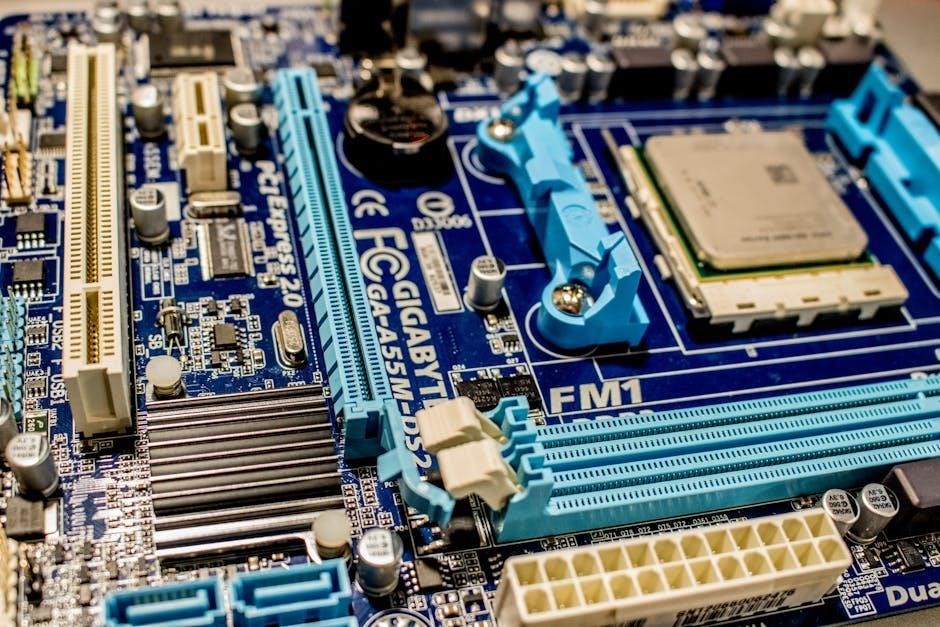The role of a computer-based instructional system is to deliver messages to learners through various means, originating from human tutors who developed these systems to facilitate learning and instruction effectively always online.
Definition and Explanation
A computer-based instructional system refers to a teaching approach that integrates computer software programs with other teaching materials in the classroom, utilizing a systems approach to instructional design. This definition encompasses various terms, including computer-based training, computer-assisted instruction, and computer-assisted learning. The role of such a system is to deliver messages to learners, originating from human tutors who developed these systems to facilitate learning and instruction. The systems approach views a problem or situation in its entirety, considering all its ramifications, interior interactions, and exterior connections. This approach is essential in the design phase, where instructional designers select or design appropriate interactive computer-based learning activities, guided by learning outcomes. By understanding the definition and explanation of computer-based instructional systems, educators can harness the potential of technology to enhance the learning experience, making it more effective and engaging for students. Effective implementation of these systems can lead to improved learning outcomes.
Role in Education
Computer-based instructional systems play a vital role in education, enhancing the learning experience and increasing student engagement. These systems provide access to a wide range of educational resources, including interactive lessons, simulations, and games. By utilizing computer-based instructional systems, educators can cater to different learning styles, allowing students to learn at their own pace. This approach also enables teachers to track student progress, identifying areas where students may need additional support. Furthermore, computer-based instructional systems can help reduce educational costs, making high-quality educational resources more accessible to a wider audience. The integration of technology in education has the potential to improve learning outcomes, increase student motivation, and prepare students for success in an increasingly technology-driven world. Effective implementation of computer-based instructional systems can have a positive impact on education, leading to a more efficient and effective learning process. This can ultimately lead to better academic performance and increased student achievement.

Systems Approach to Instructional Design
Overview of Systems Approach
Instructional Design Process

Types of Computer-Based Instructional Systems
Computer-based instructional systems include traditional and advanced systems, using various
to support learning and instruction effectively always online every day.
Traditional Systems
Traditional computer-based instructional systems, such as computer-aided instruction (CAI) or computer-based instruction (CBI), were designed to deliver instructional content to learners through a variety of means, including text, images, and audio. These systems were often used to support drill and practice exercises, tutorials, and simulations, and were typically designed to be used in a classroom or training setting. The role of these systems was to provide learners with a self-paced and interactive learning experience, with the goal of improving learning outcomes and increasing learner engagement. Traditional systems were often limited by their lack of interactivity and flexibility, but they laid the foundation for the development of more advanced computer-based instructional systems. Many traditional systems, such as PLATO and TICCIT, were widely used in the past and are still used today in some contexts, providing a range of instructional activities and supporting different learning styles and needs. Overall, traditional systems played an important role in the development of computer-based instruction.
Advanced Systems
Advanced computer-based instructional systems have evolved to provide more interactive and immersive learning experiences, using technologies such as artificial intelligence, virtual reality, and multimedia. These systems can adapt to individual learners’ needs and abilities, providing personalized instruction and feedback. They also often include features such as simulation-based learning, game-based learning, and collaborative learning tools. The role of advanced systems is to provide learners with a more engaging and effective learning experience, using a range of instructional strategies and techniques to support different learning styles and needs. Advanced systems can also provide real-time feedback and assessment, allowing instructors to track learner progress and identify areas for improvement. Additionally, advanced systems can be integrated with other technologies, such as learning management systems and educational software, to provide a comprehensive and seamless learning environment. Overall, advanced systems have the potential to transform the way we learn and teach, providing new opportunities for instruction and learning. They offer a range of benefits and opportunities.

Evaluation of Computer-Based Instructional Systems
Evaluation involves assessing the effectiveness of computer-based systems using various methods and criteria to determine their impact always online and improve instruction effectively every time with new technologies.
Strengths and Weaknesses
The role of a computer-based instructional system has several strengths, including increased accessibility and flexibility, allowing learners to access course materials at their own pace.
The systems also provide immediate feedback and assessment, enabling learners to track their progress and identify areas for improvement.
Additionally, computer-based instructional systems can be easily updated and modified, ensuring that course materials remain relevant and current.
However, there are also weaknesses, such as the potential for technical issues and limited interaction with instructors and peers.
Moreover, some learners may experience difficulty navigating the system or require additional support, which can hinder their learning experience.
Overall, understanding the strengths and weaknesses of computer-based instructional systems is crucial for effective implementation and to maximize their benefits in education.
By acknowledging these factors, educators can design and deliver high-quality online courses that cater to diverse learning needs and styles, ultimately enhancing the learning experience.
This requires careful consideration of the system’s design, functionality, and support services to ensure a positive and productive learning environment.
Effectiveness in Education
Computer-based instructional systems have been shown to be effective in education, with studies demonstrating improved learning outcomes and increased student engagement.
The use of technology-enhanced instruction can help to personalize learning, allowing students to learn at their own pace and focus on areas where they need improvement.
Additionally, computer-based instructional systems can provide real-time feedback and assessment, enabling teachers to track student progress and identify areas where additional support is needed.
The effectiveness of these systems is also evident in their ability to increase access to education, particularly for students who may not have had access to traditional educational institutions.
Overall, the role of computer-based instructional systems in education is to enhance the learning experience and improve student outcomes.

By leveraging technology, educators can create interactive and engaging learning environments that cater to diverse learning styles and needs.
This can lead to improved academic achievement and increased student motivation, ultimately preparing students for success in their future careers and endeavors.
Effective implementation is critical to achieving these benefits.

